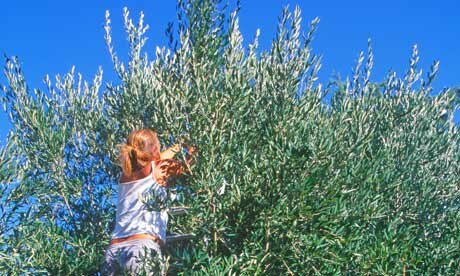A short break on an Andalucian finca gives an insight into the legendary fruit – harvesting it, classifying it – and cooking with it. Lucy Gilmore writes about GoLearnTo.com’s olive harvest and cooking course for the Observer today.
Spitting and spluttering, I choked up the last fragments of bitter fruit. I had thought that working in the fields during the olive harvest would mean popping the odd one into your mouth while the farmers weren’t looking. You’re very welcome to help yourself, in fact – if you fancy scraping the acidic aftertaste off your tongue for the next few hours. To be even vaguely palatable, olives have to be soaked in water for around two weeks and then marinated in salt water, garlic and herbs for another month or so. Lesson number one.
 At the start of the day Francisca had handed me a straw hat and a basket, which I hung round my neck, and pointed me towards an olive-laden tree. The farm in Andalucia has around 500 olive trees, in regimented rows across the stony hillside. Her uncle, armed with a large stick, started to beat the branches and the olives fell into the net below. Hand-picking is still the best method, however, as the fruits aren’t bruised, although these days it’s often not cost-effective. We were picking green olives by hand for eating, which are harvested from September to November. The black olives are harvested later (November to April) and are used to make olive oil.
At the start of the day Francisca had handed me a straw hat and a basket, which I hung round my neck, and pointed me towards an olive-laden tree. The farm in Andalucia has around 500 olive trees, in regimented rows across the stony hillside. Her uncle, armed with a large stick, started to beat the branches and the olives fell into the net below. Hand-picking is still the best method, however, as the fruits aren’t bruised, although these days it’s often not cost-effective. We were picking green olives by hand for eating, which are harvested from September to November. The black olives are harvested later (November to April) and are used to make olive oil.
I was on an olive harvest and cookery break which combines picking olives with local farmers – followed by a rustic picnic in the olive grove – with a private olive oil tasting in the nearby town of Priego de Córdoba and a lesson on cooking with olive oil at Finca Las Encinas, a rambling 170-year-old farmhouse. It’s a crash course in all things olive-related.
Lesson two: more common misconception-bashing. Think olive oil and you probably think of Italy, but Spain is the largest olive oil producer in the world – way ahead of Italy and Greece. In fact, much of the oil bottled in Italy actually comes from Spain.
“Italy is just better at marketing itself,” the owner, Clive Ridout, had explained over breakfast, a gargantuan spread of local cured meats, sheep’s cheese, freshly squeezed orange juice, chopped melon, kiwi and pears, and “Andalucian toast”. This is bread rubbed with raw garlic and drizzled with olive oil; you add a dollop of grated tomato and finally sprinkle it with salt. Delicious.
“The Spanish have olive oil with everything. It goes really well with toast and jam, too,” he added.
Clive, a Welsh chef, and his Japanese wife Maki, bought Finca Las Encinas, in the little village of Los Juncares, in 2003 and converted it into a higgledy-piggledy four-bedroom guest house. Clive runs Spanish cookery courses focusing on contemporary Andalucian cuisine throughout the year, while Maki organises olive oil tastings and farm visits – and looks after their five-year-old trilingual son, Cei.
The little house stands on a hill on the edge of the whitewashed village, with panoramic views over dusty slopes pricked with gnarled olive trees. Inside there are terracotta tiles, rough beams, thick white walls and headboards made out of old doors. In the winter, underfloor heating and a woodburning stove keep it cosy. Outside, strings of vivid red chillies adorn the walls, the terrace is scattered with pots of geraniums, and the swimming pool is surrounded by deckchairs. In the summer, you can breakfast under a vine-draped arbor next to a dreamily scented jasmine. Figs, pomegranates and, of course, olives grow in the grounds.
Leaving Clive to his chopping and cookery preparation for the next day, Maki and I wound our way through the Sierras Subbéticas Natural Park to meet Andreas, a local olive oil VIP. He is one of the 12 official tasters in charge of oil classification. The tasters are secreted away in different rooms and test the batches of oil privately. It is their say-so that decrees whether the oil is classed simply as olive oil, virgin olive oil or – the crème de la crème – extra virgin olive oil. But first we were going to pay homage to a 1,800-year-old olive tree – that still produces fruit.
“Andalucia has a growing area roughly the size of Wales,” Clive had thrown in earlier, adding that it produced 75% of Spain’s olive oil – and it was easy to believe. Every hillside seemed to be carpeted in shimmering silvery-leaved trees. Pulling over on a dusty track, we joined Andreas, who pointed out the three different types of olive tree grown in the region: the hojiblanca (which makes a spicy olive oil), the picuda (the main variety – but not the most productive) and the picual (one of the most productive varieties with smaller, bitter olives which contain lots of antioxidants). The best oil is produced from a mix of olive varieties, he explained.
We carried on to Priego de Córdoba, where it was time to get down to business. At a huge glass table, the legs made of giant olive tree trunks, Andreas gave us a sheet marked with tasting criteria.
The defects that the tasters are looking for include humidity, fermentation, and a vinegary, metallic or rancid flavour. The quality of the oil is determined by its fruitiness, bitterness, sweetness (or smoothness), spiciness and “greenness”. We had three small glasses in front of us. We warmed them with our hands before inhaling and then tasting. The tip of the tongue detects sweetness, the side and middle bitterness and the back of the tongue and the throat register spiciness.
Andreas turned up his nose at the first oil. He didn’t even need to taste it. The second was vinegary, but had good fruitiness: a virgin olive oil. The third, however, was the champagne of olive oils.
“Mmm, I can smell the green grass,” I murmured, surprised. It was like a freshly cut lawn on a summer’s day.
“Yes, and can you detect green tomatoes?” Andreas breathed in deeply. It had “roundness”, bitterness, spiciness and sweetness in perfect harmony.
Back at the finca, Clive was preparing to show us how to whip up some tapas. The wine was flowing, Cei was running in and out and Smoky the dog was curled up under the table. Donning aprons, we lined up to tackle peppers stuffed with salt cod, pork in paprika, prawns in chocolate sauce, and clams with Serrano ham. But first things first: “Take the bottle of olive oil – Senorio de Vizcantar is the second-best olive oil in the world…”
Golearnto.com (+44(0)208 144 5990; golearnto.com) offers a four-day, three-night olive harvest experience and cookery short break at Finca Las Encinas farmhouse from £353 per person, including half-board accommodation with wine and olive oil tasting in Priego de Córdoba, but excluding flights. The same finca also has tapas or paella courses from £158.
To read the full article in the Observer, click here






 Designed by
Designed by